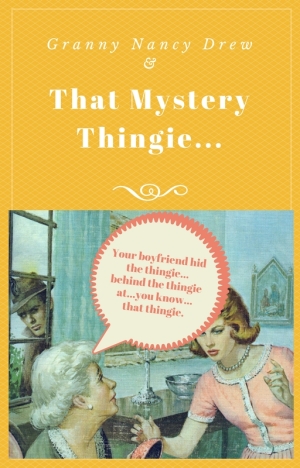Tags
amateur detective, book review, cozy mystery, Cynthia Harrison, humor, menopause, Nancy Drew, woman detective

Une femme d’un certain age… [This intro —a repeat from a few years back—came to mind when I read Cynthia Harrison’s new cozy mystery introducing mature, albeit reluctant, amateur detective Jane.]
What happens when Nancy Drew grows up?
In most long-running mystery/thriller series, the protagonist stays pretty much the same from book to book. Watson never checks Sherlock into the Old Sleuths Home. Bunter never ends up pushing a drooling Lord Peter Wimsey around in his wheelchair. The Scooby Gang never get their AARP cards and reminisce about that time they had to have Scooby Doo put down.
But what if their stories did mark the passage of time? I tried to imagine what would happen when ace girl detective Nancy Drew grows up.
NANCY DREW: Woman detective of a certain age
Nancy becomes a lawyer like her dad, whose first name is apparently Mister. Her chum Bess—following a long career on a popular soap opera—is a celebrity spokesperson for a weight loss chain, while other bestie George came out at last, and is now team-teaching computer engineering with her wife out at Berkeley. Nancy and Ned get married, and have two sons, Nan JR and Mister. Ned (who never graduated from Emerson College because he had to leave every episode to rescue Nancy from being bound and gagged) stays home to raise the boys while Nancy continues to stumble across mysteries every time she backs her (Lexus) roadster out of the driveway. The houses on either side are vacant and other neighbors avoid her, because anyone who has a conversation with Nancy Drew-Nickerson is found dead about fifteen pages later.
But lately, Nancy has been having a few problems. During the de rigueur bound-and-gagged scene in each book, she starts to wonder why Ned can’t be more… exciting…in the bedroom. When she unmasks Bess’ latest boyfriend as the villain’s accomplice, a hot flash has her opening the window (through which he immediately escapes). Every time she goes to make a list of clues, she forgets why she went into her study and ends up catching up with her chums on Facebook or playing Candy Crush on her phone. While investigating, she has trouble remembering some words and has taken to using “thingie” instead. When she finally catches the villains in the act, she starts to cry. Then, a minute later when one of them makes a crack about her new mustache, she thinks, “Screw this.” And shoots them. Lots. With her thingie.
So maybe Nancy Drew doesn’t make the transition into a grown woman. But in Cynthia Harrison’s new release, her mature heroine Jane becomes involved in investigating crimes including the murder of a local artist.
BLURB: Jane in St. Pete by Cynthia Harrison
Widowed art lecturer Jane Chasen is not an impulsive woman. Why, then, does the formerly methodical workaholic quit her job, sell her house, and move from Detroit to Florida? Instead of pondering her atypical behavior, she takes a closer look at a neighbor’s intriguing outdoor art installation. Days later, Detective Jesse Singer discovers the murdered artist in his studio. With Jane’s help, Singer finds the victim’s bloody shirt, inexplicably located within Jane’s gated community. Singer knows nothing about art, and as he closely questions Jane, she offers to help with the art angle of the case. Singer soon takes Jane up on her offer. Then, Jane begins to receive anonymous threats. Singer, determined to protect Jane, keeps her closer to his side than ever—she’s not complaining.
 My Review: 4 stars out of 5 for Jane in St. Pete by Cynthia Harrison
My Review: 4 stars out of 5 for Jane in St. Pete by Cynthia Harrison
When Sherlock Holmes, Lord Peter Wimsey, Harry Bosch, or James Bond get older (or at least the actors playing them do), they just brush back a few (distinguished, of course) gray hairs and carry on carrying on with younger (beautiful, also of course) women. But what happens when female detectives get older? Is there a stop between teenage Nancy Drew and little old Miss Marple with her knitting?
Author Cynthia Harrison gives us a mature woman as amateur detective in her latest cozy mystery, Jane in St. Pete. Following the mostly unlamented demise of her workaholic husband Stan—whose only redeeming feature seemed to be that his unexpected death saved her the time and expense of filing for divorce—Jane left her old job and life in Detroit to move to Florida. She’d spent decades in a loveless relationship for the usual reasons. “She stayed for the kids. For the financial security. For the insurance. For the appearance of a normal family.”
Instead of the divorce she always promised herself, Jane became more like Stan, throwing herself wholly into first raising her two children and then into her career as an art lecturer. When we meet her, Jane is literally standing at the door of her new Florida life, having left job, house, and identity as ‘Stan’s wife’ behind in Detroit. Before her is a vibrant Florida lifestyle in Winding Bayou, an “over-fifties” community in which her mid-fifties age makes her one of the youngest residents.
Although she’s left her art career behind, Jane is instantly captivated by the outsider art created by a local native artist, Waylon Silvercloud. But Jane and her new friends at Winding Bayou are stunned when the artist is found brutally murdered. As more of her new friends are drawn into the investigation, a Jane is asked to help detective Jesse Singer with the art-related aspects to the crime.
And that’s where, for me, this book became interesting. There were plenty of red herrings along the way, including a disconnected and basically superfluous romantic subplot involving a younger neighbor and an FBI agent. But the solution to the crime was fairly obvious, and the motive frankly unlikely. That didn’t really matter beside the gift of seeing Jane slowly unfold like one of the local Florida blossoms.
When she first arrives in Florida, Jane is almost shocked by how comfortable her new “senior” neighbors are with emotions she’s locked away—attraction, lust, romance, jealousy. It’s interesting to follow Jane’s emotional journey as she opens herself to these soul-shaking feelings of pain mixed with fragile but growing romantic attraction. In addition, we see Jane navigate her archetypal role as mother to her angry daughter, and daughter to her own wise mother. And of course, there’s the fun of seeing fish-out-of-water Jane trying to adapt to her new Florida surroundings. When shots ring out during a trip to a local restaurant, Jane is stunned as everyone around her brings out their gun, from her friends to the waitress and the musicians.
‘I don’t own a firearm,’ Jane said. George and Kim turned amazed faces toward hers. ‘This is Florida, everybody owns a gun,’ Kim said.
If it wasn’t for the pleasure of following Jane’s character change and develop, this would be a far less interesting and entertaining book. But seeing a mature woman step up to help and defend her friends, investigate a crime, and build a new life while slowly accepting herself as worthy of sexual feelings and romantic emotions is what, for me, makes Jane in St. Pete a recommended read.

I reviewed Jane in St. Pete for Rosie’s Book Review Team
***I received this book from the publisher or author to facilitate an honest review. This does not affect my opinion of the book or the content of my review.***



Thanks Barb. I like your take on a grown up Nancy Drew and Jane in St Pete sounds like an easy book to read lounging in the garden in the sunshine. The author is new to me. I may just get a copy of the book.
Happy Christmas to you and yours
LikeLiked by 2 people
Somebody should really write the Nancy Drew! I’m liking her for US Supreme Court nominee…
LikeLike
Thank you Barb.
LikeLiked by 1 person
That’s a Nancy Drew I would read 😉
LikeLiked by 2 people
I’m thinking she runs for governor, gets tapped for US Vice-President, and ends up on the Supreme Court, at which point Ned sues for divorce and writes a tell-all blockbuster.
LikeLike
Why are you not writing this, Barb ? ;D
LikeLike
Those pesky copyright laws… (Although there are the parody exceptions. Hmmm.)
LikeLike
Parody has to work here…
LikeLiked by 1 person
I am a fan of Cynthia Harrison, and loving the sound of this book!
LikeLiked by 1 person
I feel like Jane is someone we all know VERY well.
LikeLiked by 1 person
I felt that too, Barb!
LikeLiked by 1 person
Ah – like you, I found the character relationships/family stuff the most interesting part of this book. I remember finding that with another of Cynthia’s books – there was a crime element but what I liked was a great portrayal of life with an alcoholic. I wonder if she ought to turn her hand to serious, complex family dramas – it would appear to be a real strength of hers!
LikeLike